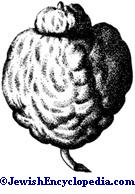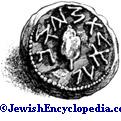ETROG ( , and
, and  in Ḳid. 70a;
in Ḳid. 70a;  in Targ. Yer. to Lev. xxiii. 40; compare the Arabic "turujjah"):
in Targ. Yer. to Lev. xxiii. 40; compare the Arabic "turujjah"):
The citron (κίτρον, κίτριον); fruit of a tree of the orange and lemon family. It is oblong in shape, and sometimes as much as six inches in length. The skin is thick, somewhat hard, fragrant, and covered with protuberances; the pulp is white and subacid. Modern naturalists assume the north of India to be its native home; but it passed to the countries of the Mediterranean from Media or Persia; hence the name of the tree, "Citrus medica," and of the fruit, "Malum medica," or "Malum Persica" (compare Pliny, "Historia Naturalis," ii. 3; μηλον Mηδικόν, Josephus, l.c. iii. 10, § 4: της IIερσέας). It is therefore possible that the Jews brought the tree with them from Babylonia to Palestine on their return from the Captivity.

The etrog is used with the "lulab" at the Feast of Booths, or Sukkot. Of the four species of plants enumerated in Lev. xxiii. 40 (R. V.), on which the carrying of the lulab is based, tradition takes "the fruit of the goodly tree" (
 , properly "the fruit of a fair or noble tree") to designate the citron. For the haggadic justification of this interpretation see Suk. 35a, and for a further discussion of the subject see Lulab. It is evident from Josephus and the Talmud that the custom of carrying the lulab and the etrog was well established in the time of the Maccabees. Josephus ("Ant." xiii. 13, § 5) relates that once, while Alexander Jannaæus was ministering at the altar on the Feast of Booths, the people pelted him with their citrons, reproaching him withbeing the son of a captive woman and therefore debarred from the priesthood. In Suk. 48b the episode of being pelted with etrogs is related of an unnamed Sadducee who wrongly poured out the waterlibation at the foot of the altar.
, properly "the fruit of a fair or noble tree") to designate the citron. For the haggadic justification of this interpretation see Suk. 35a, and for a further discussion of the subject see Lulab. It is evident from Josephus and the Talmud that the custom of carrying the lulab and the etrog was well established in the time of the Maccabees. Josephus ("Ant." xiii. 13, § 5) relates that once, while Alexander Jannaæus was ministering at the altar on the Feast of Booths, the people pelted him with their citrons, reproaching him withbeing the son of a captive woman and therefore debarred from the priesthood. In Suk. 48b the episode of being pelted with etrogs is related of an unnamed Sadducee who wrongly poured out the waterlibation at the foot of the altar.
The etrog is also called "Adam's apple," or "paradise apple," and in Gen. R. xv. 7 among other fruits the etrog is suggested as having been the forbidden fruit of which Adam and Eve ate in the Garden of Eden; "for it is said, 'the tree was good for food' (Gen. iii. 6). Which is the tree whose wood can be eaten as well as its fruit? It is the etrog."

To see an etrog in a dream is regarded as an assurance that one is "precious [ ] before his Maker" (Ber. 57a). It is a wide-spread, popular belief that a pregnant woman who bites into an etrog will bear a male child.
] before his Maker" (Ber. 57a). It is a wide-spread, popular belief that a pregnant woman who bites into an etrog will bear a male child.
In modern times, especially since the anti-Jewish demonstrations of 1891 at Corfu, a movement was inaugurated to boycott the etrog-growers of that island and to buy etrogim raised in the agricultural colonies of Palestine. Isaac Elhanan SPECTOR favored the Palestinian fruit ("Almanach Achiasaf," iv. 293), while others contended that the etrogim of Palestine, being raised on grafted trees, were prohibited ("Peri 'Eẓ. Hadar," ed. Solomon Marcus, Cracow, 1900).
The etrog was occasionally the object of special taxation. Empress Maria Theresa demanded from the Jews of the kingdom of Bohemia July 17, 1744, an annual tax of 40,OOO florins ($16,000) for the right of importing their etrogim, which tax was later on reduced to 12,000 florins ("Oest. Wochenschrift," 1901, p. 727). Some Galician Jews in 1797 offered to pay 150,000 florins for the privilege of levying a tax on etrogim, but Emperor Francis II., in 1800, refused to interfere with a religious practise ("Israel. Familienblatt," Hamburg, Oct. 10, 1901).

- Tristram, Natural History of the Bible, pp. 347 et seq.

